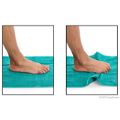Flatfoot (Pes Planus)
Condition Basics
What is flatfoot?
Flatfoot (pes planus) is a condition in which the longitudinal arch in the foot, which runs lengthwise along the sole of the foot, has not developed normally and is lowered or flattened out. One foot or both feet may be affected.
Children as well as adults may be flat-footed. Most children are flat-footed until they are between the ages of 3 and 5 when their longitudinal arch develops normally.
What causes it?
Flatfoot may be an inherited condition or may be caused by an injury or condition such as rheumatoid arthritis, stroke, or diabetes.
What are the symptoms?
People who have flat feet rarely have symptoms or problems. Some people may have pain because of:
- Changes in work environment.
- Minor injury.
- Sudden weight gain.
- Excessive standing, walking, jumping, or running.
- Poorly fitted footwear.
Children sometimes have foot discomfort and leg aches associated with flat-footedness.
How is flatfoot treated?
Treatment in adults most often includes wearing spacious, comfortable shoes with good arch support. Your doctor may recommend padding for the heel (heel cup) or orthotic shoe devices. Orthotics are molded pieces of rubber, leather, metal, plastic, or other synthetic material that are inserted into a shoe. They balance the foot in a neutral position and cushion the foot from extra pounding.
For children, treatment using corrective shoes or inserts is rarely needed, as the arch usually develops normally by age 5.
Surgery is rarely needed.
You may be able to relieve heel pain by:
- Stretching tight calf muscles. For example, try standing calf stretches that are done against a wall.
- Doing foot-strengthening exercises with a towel and weights. Towel scrunches are one example.
- Doing foot-stretching exercises with a towel. For example, try seated calf stretches.
Some people may choose more intensive strengthening and flexibility programs. This may include competitive athletes, people who want to return to a heavy sports program, or people who are highly motivated. A physical therapist or trainer can help supervise a program recommended by your sports medicine specialist or a foot specialist, such as an orthopedist or podiatrist.
Treatment with nonsteroidal anti-inflammatory drugs (NSAIDs), heat, or massage may help with foot pain and leg discomfort. If flatfoot is related to another condition, surgery or other treatment may be needed.
Credits
Current as of: July 24, 2025
Author: Ignite Healthwise, LLC Staff
Clinical Review Board
All Ignite Healthwise, LLC education is reviewed by a team that includes physicians, nurses, advanced practitioners, registered dieticians, and other healthcare professionals.
Current as of: July 24, 2025
Author: Ignite Healthwise, LLC Staff
Clinical Review Board
All Ignite Healthwise, LLC education is reviewed by a team that includes physicians, nurses, advanced practitioners, registered dieticians, and other healthcare professionals.


